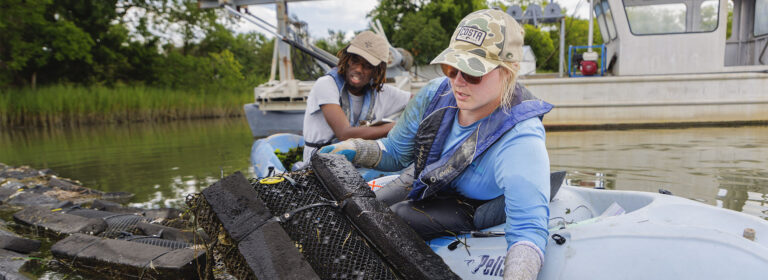Researchers add secret ingredient to improve plant growth Through aquaponics
Behind every healthy plant is a team of tiny microbes on their roots, and they play a huge role in plant health. They help plants grow, produce hormones for the plant, lower plant stress, provide nutrients, and even ward off disease. Together, this microbial team is known as the microbiome.
Ordinarily, plants rely on the microbes available in the soil wherever they’re planted. But in hydroponic systems, where plants grow in water, researchers like Scott Lowman and Emily Zhou at the Institute for Advanced Learning and Research (IALR) can deliberately add beneficial bacteria to the plant root system.
These tiny microbes have a huge payoff. Plants given a mix of these beneficial bacteria grow much bigger — and faster. When the indoor greenhouse is at full capacity at IALR, Zhou can have almost 1,500 plants growing at once. Their growth is carefully monitored, and the temperature, humidity, light exposure, and water pH are fine-tuned for optimal growth. During the first hydroponic plant trials at in the IALR greenhouses, Zhou saw as much as 60 percent more growth compared to traditional planting methods in soil.
“In the plant world, that’s unheard of,” Lowman said.
Aquaponic produce doesn’t just grow faster, it often has a longer shelf-life, too. This can be a selling point for growers, and reduce food waste for consumers.
“You might buy your hydroponic lettuce for $3 or $4, and if it [grows] this big, that’s very attractive,” Zhou said. “Also, they can keep in the refrigerator for a month or four weeks, still fresh.
Lettuce and tilapia: an unlikely but effective duo
Plants have relied on the microbes in their roots for thousands of years, researchers are just now beginning to identify the individual microbes and their role in the microbial team in the last 20 years. Since very few types of bacteria can be cultured in the lab, as much as 99 percent of bacteria on the planet have not been studied.
And, for the fraction of bacteria that can be cultured, developing the right blend of microbes that is most helpful for plants can take a lot of time and effort. Now, the team is adding a new, natural source of beneficial bacteria: the microbiome from fish aquaculture.
The IALR is collaborating with aquaculture specialists at the Virginia Tech Seafood Agricultural Research and Extension Center (VSAREC) to study this emerging combination of aquaculture and hydroponics known as aquaponics. In this new study, VSAREC provides the water from the fish tanks, and IALR will monitor plant growth. Together, they’ll investigate the microbial community that makes this combined system successful.
In addition to the microbes, the water from fish tanks is rich in nitrogen, which helps fertilize the plants. In an aquaponics system, nutrients from the fish are extra effective as fertilizer, since the water-based system brings nutrients to the plant roots faster than in soil.
The plants and the microbes in their roots also help the fish by removing ammonia from the water before it recirculates to the fish tanks. This nitrogen-rich compound helps the plants grow, and prevents an ammonia buildup in fish tanks that can sicken or kill the fish.
“The bacteria that sequentially convert ammonia to nitrite and then nitrate, that’s the heartbeat of the system,” VSAREC Director Michael Schwarz said.
“The bacteria that sequentially convert ammonia to nitrite and then nitrate, that’s the heartbeat of the system,” VSAREC Director Michael Schwarz said.
Healthy plants start with healthy water
The same microbes that are key to the aquaponic systems add an extra safety consideration: unlike fish, which are typically cooked carefully to kill any bacteria, leafy greens like lettuce — a common choice for aquaponic systems — are consumed raw. As of right now, there have been no recalls of aquaponic-grown produce for bacterial contamination, VSAREC Food Safety Specialist Reza Ovissipour said. The teams at VSAREC and IALR are working to keep it that way.
The primary concern is pathogenic bacteria: the rough, textured lettuce leaves can provide hiding spots where bacterial can hide. The bacteria can then form strong groups called biofilms, which are much harder to clean or destroy than individual cells.
Ovissipour is applying a new method to treat the water and produce from aquaponic systems, called nanobubbles. These tiny bubbles contain a form of oxygen called ozone, and burst the bacterial cells in a way similar to bleach. But unlike bleach or other chemical sanitizers, the nanobubbles can clean the water without killing the plants growing in the system.
Researchers at AREC have also developed an example food safety plan that real aquaponics businesses can use as a model to make their own individual plans.
The plants grow fast — and businesses can, too
Although lettuce and tilapia are a standard example for aquaponics, the possible combinations are nearly endless. Ornamental fish, food fish, freshwater fish, and saltwater fish can be paired with a variety of plants, although many systems focus on leafy greens that grow fuller and faster in the aquaponic system.
VSAREC Extension Specialist Jonathan van Senten, who focuses on aquaculture economics and marketing, has worked with aquaponics businesses to help them develop business plans. Growing high-value crops on a faster timeline is part of what makes this business economically attractive, he said.
“We’re looking to make aquaponics a turn-key operation,” van Senten said.
Takeaways:
- Aquaponics, a combination of aquaculture and hydroponics, allows nutrients from fish tanks to fertilize plants. The plants, in turn, reduce ammonia buildup in the water, keeping the fish healthy.
- VSAREC and IALR researchers are further studying the key to aquaponic systems’ success: the helpful bacteria.
- VSAREC specialists have also created food safety and business planning resources tailored to the unique challenges and opportunities in aquaponics.
Photos and video by Aileen Devlin | Virginia Sea Grant
Story by Madeleine Jepsen | Virginia Sea Grant
Published December 16, 2021.
Aquaponic produce doesn’t just grow faster, it often has a longer shelf life, too. This can be a selling point for growers and reduces food waste for consumers.





